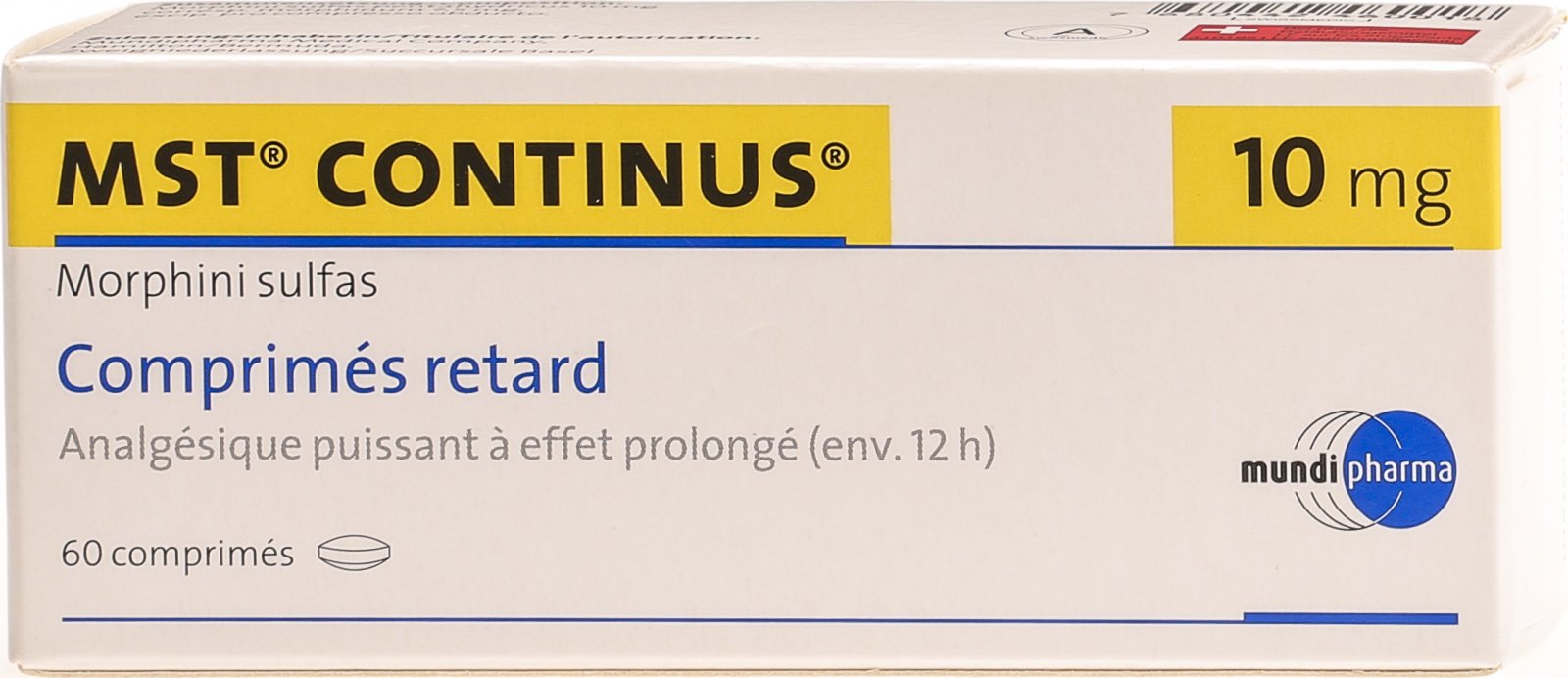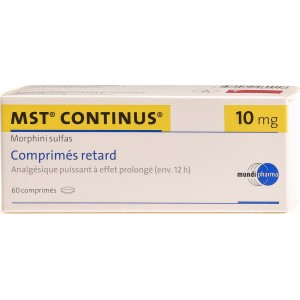Shipped From: Philippines
Shipping Method: RMS (Trackable)
Delivery Time: 10 To 15 Days
Availability:
Buy Morphine 10mg Online
Buy Morphine Online without prescription
What is Morphine and when is it used?
Morphine is a pain reliever for the treatment of persistent pain of medium or severe intensity. Contains the active ingredient morphine. After taking Morphine, morphine is slowly released in the gastrointestinal tract and absorbed into the bloodstream.
Morphine should only be used on prescription and under regular medical supervision.
Warning
If you are hypersensitive (allergic) to the active substance morphine or to one of the auxiliary substances,
if you suffer from severe breathing problems, i.e. your breathing is shallow and slow (severe respiratory depression),
if you have severe chronic lung disease resulting in a narrowing of the airways (severe chronic obstructive pulmonary disease (COPD)),
in case of acute abdominal pain,
in the presence of paralysis of intestinal activity (paralytic ileus).
When is caution required in the administration of Morphine?
In the presence of severe increase in pressure in the right heart following pulmonary hypertension (severe cor pulmonale), severe bronchial asthma or breathing problems,
in case of severe hepatic insufficiency or renal insufficiency,
in case of thyroid insufficiency (hypothyroidism),
in case of insufficiency of the adrenal glands (Addison's disease),
in case of mental disorders caused by alcohol or from intoxication, alcoholism or severe reactions to an alcohol detox,
in the presence of gallstones or other diseases of the biliary tract,
in case of inflammation of the pancreas (pancreatitis),
in the presence of obstructive or inflammatory bowel disease,
in case of prostatic hypertrophy with difficulty urinating,
in the presence of low or high blood pressure or pre-existing cardiovascular diseases,
in case of head injury, epilepsy or tendency to seizures,
when taking medicines from the group of monoamine oxidase inhibitors (MAOIs); the use of Morphine is not indicated concomitantly with MAOI-based therapy or within 14 days after discontinuation of such therapy
if you are breastfeeding.
If you are older or physically weak, you are more likely to experience side effects. So be especially cautious.
Addiction may develop with prolonged use of STD Continus. This means that you may need a higher dose to get the desired analgesic effect.
Prolonged use of Morphine can also cause physical dependence. If treatment is stopped suddenly, withdrawal symptoms, such as restlessness, bouts of sweating and muscle aches, may occur. If you no longer need therapy, you should gradually reduce the daily dose in consultation with your doctor.
The active substance morphine has a similar abuse potential to that of all other strong pain relievers similar to morphine. There is the possibility of developing a psychic addiction. In the event of current or previous abuse of alcohol, drugs or medications, the use of Morphine should be avoided.
If you do have surgery, tell your doctors that you are taking Morphine.
A prolonged intake of morphine-like pain relievers such as STD Continusit can cause reversible hormonal changes such as decreased function of the adrenal cortex with symptoms such as nausea, vomiting, loss of appetite, fatigue, weakness, dizziness or arterial hypotension or decreased function of the sexual organs with symptoms such as decreased libido, erectile dysfunction or amenorrhea.
Morphine can impair reproductive capacity.
Some medications can increase the likelihood of side effects (particularly impaired respiratory function, hypotension, drowsiness and / or reduced alertness), which in severe cases can lead to profound drowsiness, coma and death:
other morphine-like analgesics (opioids),
sleeping pills and tranquilizers (such as benzodiazepines),
some medications for allergies, motion sickness or nausea,
some medicines against depression and psychosis,
some medicines to treat seizures and certain types of pain (e.g. phenytoin, gabapentin or pregabalin),
muscle relaxation medications (muscle relaxants).
Tell your doctor or pharmacist immediately if you are using any of these medicines.
Do not drink alcohol while being treated with Morphine. Drinking alcohol during STD Continus treatment can lead to excessive sleepiness and increase the risk of severe side effects such as shallow breathing and the consequent risk of respiratory arrest and loss of consciousness, which in severe cases can lead to coma and death.
Medicines against gastric hyperacidity (antacids) should be taken with an interval of at least 2 hours after taking Morphine suspension retard.
The use of Morphine can lead to positive doping control results.
Morphine can reduce the ability to react, the ability to drive a vehicle and the ability to use tools or machines. So ask your doctor if you can drive a car, use machines or do dangerous work.
Morphine 10 mg, 30 mg and 60 mg retard tablets contain lactose. Therefore, if you suffer from intolerance to certain sugars, we recommend that you consult your doctor before taking these Morphine dosages.
Patients hypersensitive to azo dyes, acetylsalicylic acids as well as antirheumatics and analgesics (prostaglandin inhibitors), must refrain from using Morphine 30 mg and 60 mg tablets retard and Morphine suspension retard.
Tell your doctor or pharmacist if you have any other illnesses, suffer from allergies or take or apply other medicines externally (even if purchased on your own!).
Can Morphine be taken while pregnant or breastfeeding?
Pregnancy
Prolonged use of STD Continus during pregnancy may cause withdrawal symptoms in the newborn. If Morphine is used during childbirth, it can cause slowing and flattening of the breath (respiratory depression) in the newborn. Morphine must not be administered during pregnancy. However, your doctor can make exceptions.
Feeding time
If you are breastfeeding, you should only take Morphine if your doctor considers it absolutely necessary.
Dosage of Morphine
Always take Morphine exactly as directed by your doctor. If in doubt, ask your doctor or pharmacist. The dosage depends on the intensity of the pain and your individual sensitivity and is defined by your doctor.
Morphine retard tablets are taken twice a day, at approximately the same time, with or between meals, with a sufficient amount of liquid. Retard tablets should not be divided, chewed or crushed.
Mix the contents of the Morphine 20 mg, 30 mg or 60 mg retard suspension sachet with at least 10 ml (2 tsp) of water. Mix the contents of the 100 mg sachets with at least 20 ml and the 200 mg sachets with at least 30 ml of water. Mix well for about 10 seconds and drink immediately. If there is still some granules left in the glass, fill it again with water and drink the remaining content.
The contents of the sachet can be taken after sprinkling it on cold food with a soft consistency (eg yogurt, ice cream, baby food). Take care to take the entire contents of the sachet straight away (e.g. sprinkled on a spoonful of soft food).
In case of body weight below 70 kg, advanced age or physical weakness, the normal dose at the start of therapy is two 10 mg retard tablets or the contents of one 20 mg sachet every 12 hours. If the weight exceeds 70 kg, the dose is one retard tablet or the content of one 30 mg sachet every 12 hours. If necessary, your doctor will gradually increase the dose.
For children, the doctor will individually determine the dosage schedule according to age and circumstances.
Tell your doctor if you experience pain between taking Morphine. Your doctor may prescribe a quick-release pain reliever (back-up pain reliever) to treat these breakthrough pains.
If you have taken more Morphine than prescribed, tell your doctor immediately.
Strictly adhere to the times of intake prescribed by your doctor. To have optimal protection against pain or its recurrence it is important to take the retard tablets or the retard suspension at regular intervals set by your doctor. Do not wait to take the preparation until you start to feel pain again.
Do not change the prescribed dosage on your own initiative. If you think that the action of the medicine is too weak or too strong, talk to your doctor or pharmacist.
What side effects can Morphine have?
Very often, taking STD Continus can cause constipation. You can fight this ailment with a diet rich in fiber and with the intake of sufficient quantities of fluids, but often it will be necessary for the doctor to prescribe, in addition, a laxative.
Particularly at the beginning of therapy, nausea and vomiting can occur very frequently. If you feel sick or need to vomit, please tell your doctor, who may prescribe treatment.
In addition, the following side effects may occur when taking Morphine:
Frequent: decreased or loss of appetite, confusion, insomnia, dizziness, headache, involuntary muscle spasms, severe drowsiness or lightheadedness (sedation), abdominal pain, dry mouth, sweating, rash, itching, weakness, tiredness, malaise .
Occasional: hypersensitivity reactions, excitement, euphoria, hallucinations, mood changes, seizures, increased muscle tension, paraesthesia, visual disturbances, dizziness, palpitations, flushing of the face, drop in blood pressure, fainting (syncope), accumulation of fluids in the lungs (after a sudden increase in dosage), slowing and flattening of breathing (respiratory depression), impaired respiratory function, wheezing, bowel obstruction, taste disturbances, digestive disorders, increased liver values, itchy rash (hives), urinary retention, water retention (edema).
Acute general allergic reactions, thought disturbances, dysphoria, drug dependence, excessive sensitivity to pain (hyperalgesia), pain perception for stimuli that normally do not cause pain (allodynia), narrowing of the pupils, slow heart rate, decreased stimulus may also occur cough, changes in smell, pain in the gallbladder (biliary colic), absence of menstruation (amenorrhea), erectile disorders, decreased libido, habituation in case of prolonged use or withdrawal symptoms.
Morphine retard tablets 30 mg and 60 mg and Morphine suspension retard can cause hypersensitivity reactions of the skin and respiratory system, particularly in patients with asthma, urticaria, hypersensitivity to acetylsalicylic acids and other antirheumatic or analgesic agents.
Please note that, despite the absence of menstruation, it is possible for pregnancy to occur and therefore, even in the absence of menstruation, it is necessary to use an effective contraceptive during therapy with STD Continus.
In case of suspected overdose, immediately inform the doctor who will take the necessary countermeasures. Signs of overdose are: narrowing of the pupils, extreme slowing of breathing, low blood pressure, narcosis-like state.
Respiratory paralysis is the most serious danger related to overdose.
If you notice any side effects not described here you should inform your doctor or pharmacist.
What else needs to be taken into account?
Store at room temperature (15-25 ° C) and in a place inaccessible to children.
Once the treatment is complete, take the residual medicine to a collection point (doctor's office, pharmacy) for proper disposal.
The medicinal product should not be used beyond the date indicated with "EXP" on the container.
Your doctor or pharmacist, who have detailed professional information, can give you further information.
What does Morphine contain?
Morphine retard tablets
Morphine 10 mg contains 10 mg of morphine sulphate pentahydrate (corresponding to 7.5 mg of morphine) as well as auxiliary substances (including lactose).
Morphine 30 mg contains 30 mg of morphine sulphate-pentahydrate (corresponding to 22.5 mg of morphine) as well as auxiliary substances (including lactose, yellow orange dye S [E 110], erythrosine [E 127] and indigo carmine [E 132] ]).
Morphine 60 mg contains 60 mg of morphine sulphate-pentahydrate (corresponding to 45 mg of morphine) as well as auxiliary substances (including lactose and the dyes quinoline yellow [E 104], orange yellow S [E 110] and erythrosine [E 127] ).
Morphine 100 mg contains 100 mg of morphine sulphate-pentahydrate (corresponding to 75 mg of morphine) as well as auxiliary substances (including indigo carmine dye [E 132]).
Morphine 200 mg contains 200 mg of morphine sulfate-pentahydrate (corresponding to 150 mg of morphine) as well as auxiliary substances (including the dyes quinoline yellow [E 104] and brilliant blue FCF [E 133]).
Morphine suspension retard
1 sachet contains 20 mg, 30 mg, 60 mg, 100 mg or 200 mg of morphine sulphate-pentahydrate, corresponding respectively to 15 mg, 22.5 mg, 45 mg, 75 mg or 150 mg of morphine as well as auxiliary substances (including flavoring and coloring Ponceau 4R [E 124]).

